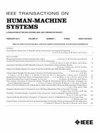Evaluating the Impact of Time-to-Collision Constraint and Head Gaze on Usability for Robot Navigation in a Corridor
IF 3.5
3区 计算机科学
Q2 COMPUTER SCIENCE, ARTIFICIAL INTELLIGENCE
引用次数: 0
Abstract
Navigation of robots among humans is still an open problem, especially in confined locations (e.g. narrow corridors, doors). This article aims at finding how an anthropomorphic robot, like a PR2 robot with a height of 1.33 m, should behave when crossing a human in a narrow corridor in order to increase its usability. Two experiments studied how a combination of robot head behavior and navigation strategy can enhance robot legibility. Experiment 1 aimed to measure where a pedestrian looks when crossing another pedestrian, comparing the nature of the pedestrian: human or a robot. Based on the results of this experiment and the literature, we then designed a robot behavior exhibiting mutual manifestness by both modifying its trajectory to be more legible, and using its head to glance at the human. Experiment 2 evaluated this behavior in real situations of pedestrians crossing a robot. The visual behavior and user experience of pedestrians were assessed. The first experiment revealed that humans primarily look at the robot's head just before crossing. The second experiment showed that when crossing a human in a narrow corridor, both modifying the robot trajectory and glancing at the human is necessary to significantly increase the usability of the robot. We suggest using mutual manifestness is crucial for an anthropomorphic robot when crossing a human in a corridor. It should be conveyed both by altering the trajectory and by showing the robot awareness of the human presence through the robot head motion. Small changes in robot trajectory and manifesting robot perception of the human via a user identified robot head can avoid users' hesitation and feeling of threat.评估碰撞时间限制和头部凝视对走廊机器人导航可用性的影响
机器人在人群中导航仍然是一个悬而未决的问题,特别是在狭窄的地方(如狭窄的走廊、门)。这篇文章的目的是寻找一个拟人机器人,像一个高度为1.33米的PR2机器人,当在狭窄的走廊里穿过人类时,应该如何表现,以增加它的可用性。两个实验研究了机器人头部行为和导航策略的结合如何提高机器人的易读性。实验1的目的是测量一个行人在穿过另一个行人时看向哪里,比较行人的性质:人类还是机器人。在实验结果和文献的基础上,我们设计了一个机器人的行为,通过修改其轨迹使其更清晰,并使用其头部看人类,从而表现出相互明显的行为。实验2评估了行人穿过机器人的真实情况下的这种行为。对行人的视觉行为和用户体验进行了评价。第一个实验显示,人类在过马路之前主要是看机器人的头部。第二个实验表明,当在狭窄的走廊中与人交叉时,修改机器人的轨迹和瞥人是必要的,可以显著提高机器人的可用性。我们建议,当拟人机器人在走廊上与人交叉时,使用相互的表现是至关重要的。它既可以通过改变轨迹来传达,也可以通过机器人头部运动来显示机器人对人类存在的意识。机器人轨迹的微小变化和通过用户识别的机器人头部来体现机器人对人类的感知,可以避免用户的犹豫和威胁感。
本文章由计算机程序翻译,如有差异,请以英文原文为准。
求助全文
约1分钟内获得全文
求助全文
来源期刊

IEEE Transactions on Human-Machine Systems
COMPUTER SCIENCE, ARTIFICIAL INTELLIGENCE-COMPUTER SCIENCE, CYBERNETICS
CiteScore
7.10
自引率
11.10%
发文量
136
期刊介绍:
The scope of the IEEE Transactions on Human-Machine Systems includes the fields of human machine systems. It covers human systems and human organizational interactions including cognitive ergonomics, system test and evaluation, and human information processing concerns in systems and organizations.
 求助内容:
求助内容: 应助结果提醒方式:
应助结果提醒方式:


